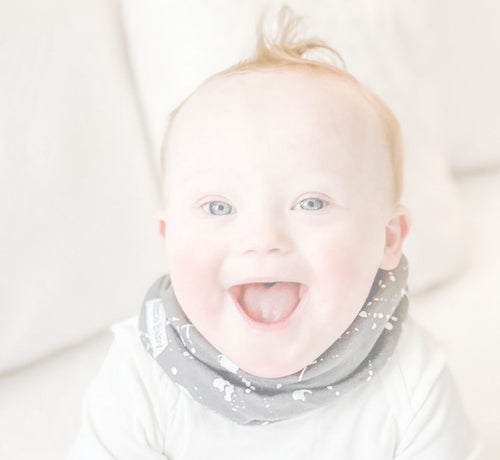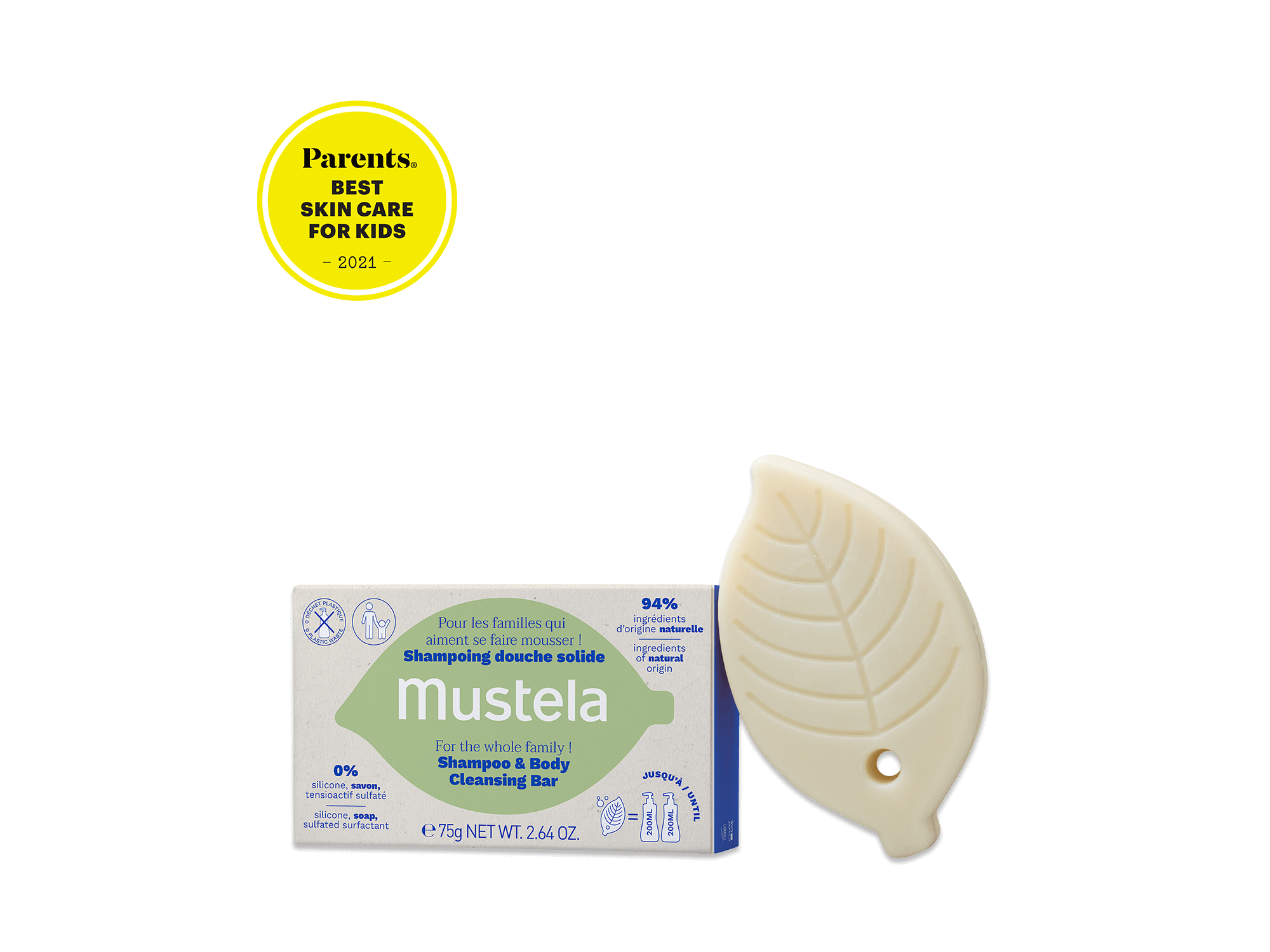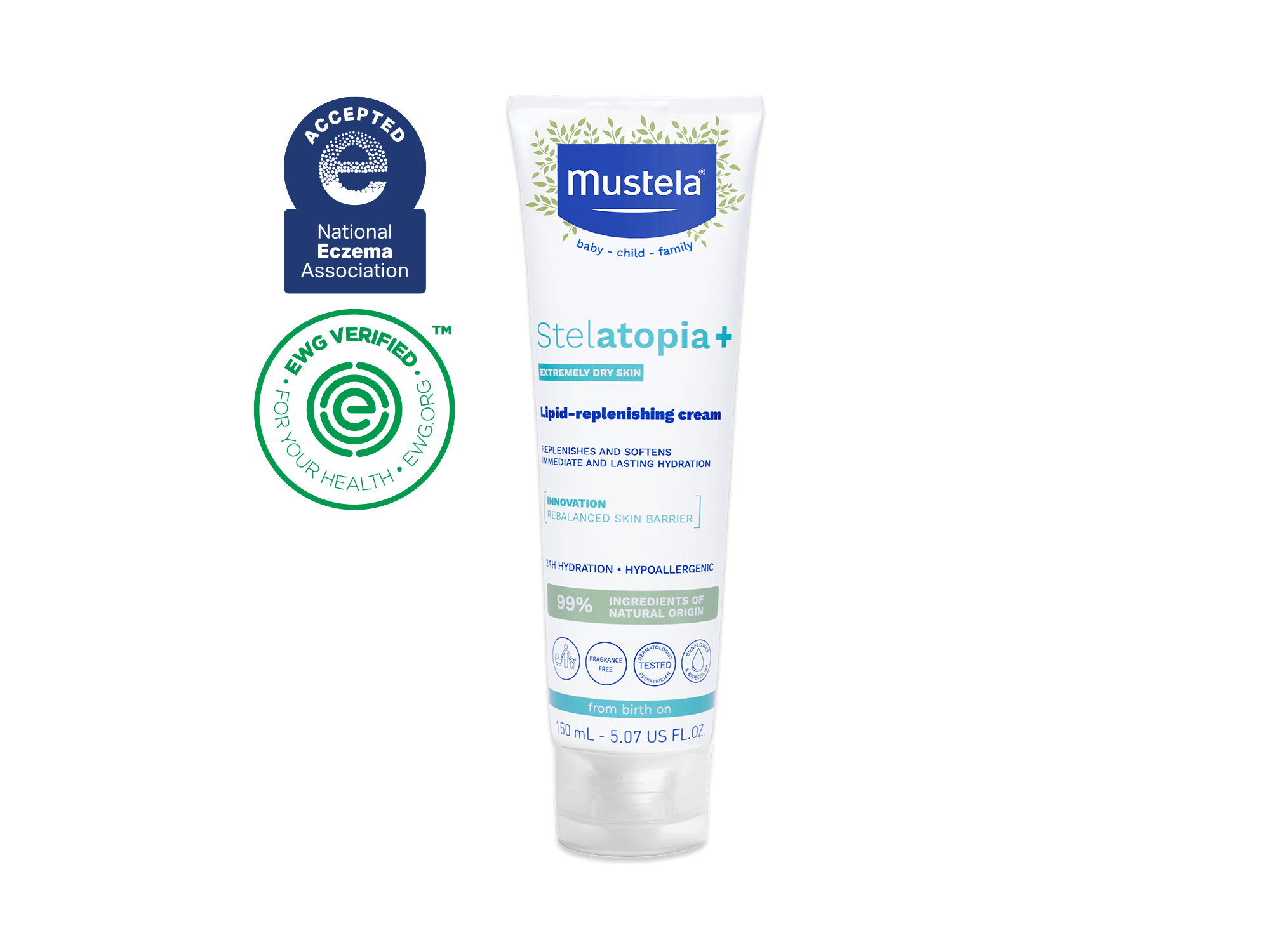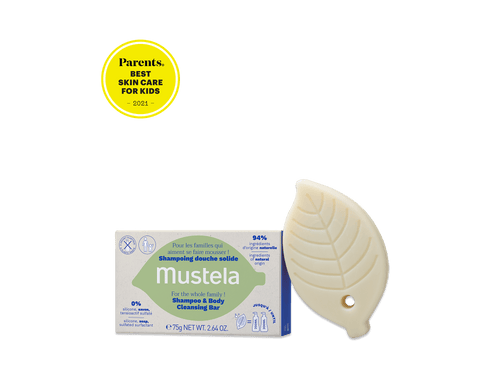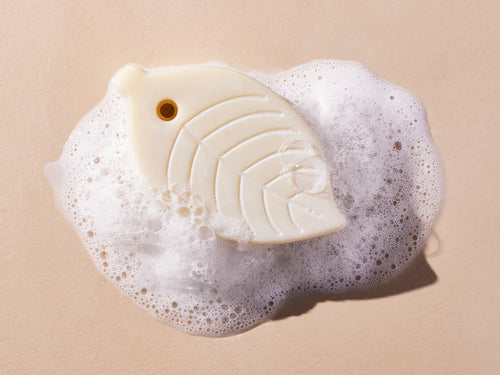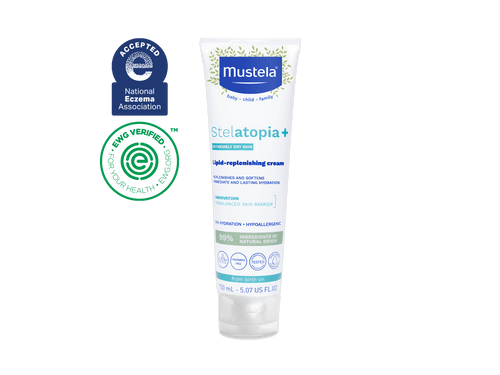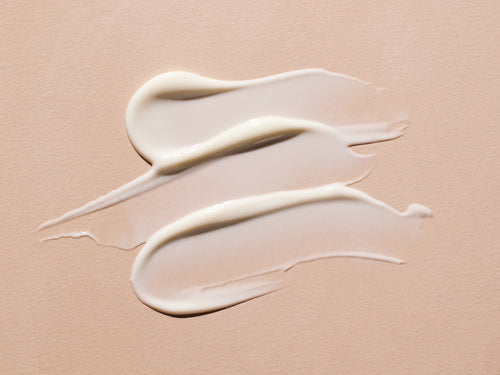When you see your baby with rosy cheeks, you might worry something is wrong. While it's true that red cheeks in a baby can sometimes be a sign of a medical problem, in most cases, it’s not a health emergency.
To help you sort out the cause of your baby's red cheeks, here's a look at some of the most common possibilities. You'll also find treatment options and tips to help you prevent this problem in the future.
Table Of Contents
- 14 Potential Causes And Treatment Options For Red Cheeks In A Baby
- When To See A Doctor
- Other Things To Consider If Your Baby Has Red Cheeks
- How To Prevent Red Cheeks In Your Baby
14 Potential Causes And Treatment Options For Red Cheeks In A Baby

1) Exertion
Have your cheeks ever gotten red while you're exercising? It's a typical response to physical activity.
Babies can experience this same thing, especially if the room is warm.
If your baby's cheeks are red after breastfeeding or while playing, they're probably starting to work up a sweat. It could also be that they’re trying a new skill (such as crawling) and pouring a lot of energy into their movements.
What To Do
To treat this redness, give your baby a break from the activity to help them cool down. Also, if they're wearing extra layers of clothing, consider removing one.
The good news is red cheeks caused by exertion typically go away on their own.
2) Teething
When babies are cutting their teeth, they often drool more than usual. This drool can irritate their sensitive skin and cause a rash around their mouth, chin, and cheeks.
This rash is red and bumpy and might be accompanied by other teething symptoms, like fussiness, chewing on things, and a low-grade fever.
What To Do
To help clear up your baby’s teething-induced drool rash, you'll want to keep their face as dry as possible.
Use our Cleansing Wipes to quickly clean up any drool or spit-up you notice. The gentle formula helps moisturize your baby's skin, protecting it from irritation.
You’ll also want to use a gentle cleanser when washing your baby’s face. Our Soothing Cleansing Gel is a great option. The fragrance-free formula is designed for babies with sensitive, rash-prone skin.
3) Eczema

Eczema is a common skin condition in babies. While you can find these patches of red, itchy, dry skin anywhere on their body, they’re often on a baby’s cheeks, elbows, and knees.
Other symptoms of eczema include scaling, crusting, and oozing skin. Your baby might also have trouble sleeping because the itchiness is so bothersome.
What To Do
If your baby has eczema, you can try home treatment options to help soothe their eczema-prone skin. A great place to start is with our Eczema Essential Set.
In the set, you'll get:
The Stelatopia Cleansing Oil is a multi-use, replenishing, oil-based cleanser for your baby’s face, hair, and body while the Stelatopia+ Lipid-Replenishing Cream immediately and continuously nourishes and moisturizes extremely dry to eczema-prone skin for up to 24 hours.
Note: Babies with eczema typically outgrow it, so you might notice it improving on its own over time.
4) Dry Skin
Dry skin can be another common cause of red cheeks in a baby. This is especially true in the winter when the air is drier and colder. Spending too much time in the bath can also cause your baby's skin to dry out.
In addition to red cheeks, you might notice your baby's skin feels dry to the touch instead of smooth and supple. It might also be visibly flaky or cracked.
What To Do
A humidifier can help add moisture to the air and prevent your baby's skin from getting too dry. Look for one specifically designed for babies. You’ll want it to have a filter to remove any harmful toxins from the air.
You'll also want to apply a safe, gentle moisturizer to their skin to help lock in moisture. For example, our Nourishing Cream with Cold Cream prevents water from evaporating, helping your baby's skin stay soft.
5) Fifth Disease
Fifth disease is a virus that typically causes a bright red rash on the cheeks. It gets its name because it's the fifth most common childhood infection.
The rash usually starts as two red spots on each cheek and then spreads to the rest of the body within a few days. It eventually turns into a lacy, red rash that can last several weeks.
Other symptoms of fifth disease include fever, runny nose, and headache. It can also cause joint pain in older children and adults.
What To Do
If your child has fifth disease, they'll usually recover on their own within a few weeks without medical intervention. However, you can help soothe their symptoms with over-the-counter medication.
Acetaminophen can relieve their fever and pain. And you can also use a cool compress to help reduce the swelling and itchiness associated with the rash.
6) An Allergy

Allergies can also cause red cheeks in a baby. This condition is usually due to an allergic reaction to something they've come into contact with, such as pollen, pet dander, or certain types of food.
In addition to the red cheeks, you might also notice watery eyes, sneezing, and a runny nose. In some cases, the rash can spread to other body parts, too.
What To Do
If your baby has a severe allergic reaction, it requires immediate medical attention.
However, even if their symptoms are mild, it’s still something you’ll want to mention to their health provider at your next visit. That way, they can help you learn what is causing the allergy and get a treatment plan established.
To prevent future reactions, you’ll want to avoid allergy triggers. This might mean keeping your baby away from pets or certain types of food.
Since their skin is so sensitive, you may also need to change your cleaning, washing, and laundry products. Switching to gentle, eco-friendly products free of harsh chemicals can help reduce the risk of an allergic reaction.
7) Contact Irritation
Another common cause of red patches on your baby's face is contact irritation. It happens when their skin comes into contact with something irritating, such as a new laundry detergent, lotion, soap, or even a parent’s perfume.
Red patches can also occur if your child rubs their face on something rough, such as the carpet, a man’s beard, or the side of their car seat. Someone giving their cute cheeks a little pinch can also cause red spots to appear temporarily.
What To Do
Red spots from your child rubbing their cheek on something often disappear within a few minutes. However, if the irritation persists or worsens, you'll need to look closely at what's causing it.
If you recently changed laundry detergents, lotions, or soaps, try switching back to the old products to see if that helps. You should also ensure your little one's clothing is gentle and free from harsh chemicals.
8) Wind-Chapped Skin

Wind and cold temperatures cause moisture to evaporate from the skin quickly, leaving it dry and irritated. You may also notice cracking or flaking in the affected area. If your baby has been outside in the cold, it could be why their cheeks look red and feel dry.
What To Do
The best way to prevent wind-chapped skin is to limit your baby's exposure to cold weather. When they are outside, make sure they're dressed warmly in a hat and scarf, and keep them away from strong gusts of wind.
You can also apply a gentle, fragrance-free moisturizer to the affected area twice daily. Our Nourishing Body Lotion With Cold Cream is a great choice. It helps reduce irritation and keeps your baby’s skin hydrated.
Using a humidifier is another way to treat wind-chapped skin since it puts moisture back into the air. But if you decide to run one, make sure it's cleaned regularly to help prevent bacteria from forming. Breathing this in can cause other health problems.
9) Skin Infection
In some cases, a red rash on your baby's face could be a sign of a skin infection. Cellulitis is one of the most common types, and it usually appears as painful red patches that are warm to the touch. It often feels tender or swollen, and you might also see blisters or areas of broken skin.
What To Do
If you suspect your baby has a skin infection, it's important to seek medical attention immediately. Treatment typically involves antibiotics to combat the infection.
Your doctor will also likely recommend keeping the affected area clean and dry, avoiding harsh soaps or perfumes, and applying a topical ointment to help the area heal.
Finally, monitor your baby's health and follow up with their health provider as needed. This will help ensure the infection doesn't spread or cause further complications.
10) Sunburn
Have you and your little one been spending a lot of time outside in the sun recently? If they’ve experienced too much sun, a sunburn is a possibility. This condition can cause redness, swelling, and blisters.
What To Do
With a sunburn, you’ll need to soothe the affected area and prevent further damage from occurring.
First, give your baby an oatmeal bath or apply cool compresses to reduce the pain and itching. Then, use a gentle moisturizer to minimize dryness and irritation.
Our Cicastela Moisture Recovery Cream is a safe and effective multi-purpose ointment that delivers soothing relief from head-to-toe.
You should also limit their exposure to the sun. Dress them in loose-fitting clothes that cover their body as well as a wide-brimmed hat. In addition, take time to apply our SPF 50 Mineral Sunscreen Lotion before you head outside.
As your baby heals, monitor their symptoms and contact your doctor if the redness, pain, or swelling worsens.
11) Frey’s Syndrome
Sometimes, after a child eats a highly flavored food, such as something spicy, tomatoes, or citrus fruits, they may experience a short-lasting red rash on their face. They may also sweat.
While this condition mimics a food allergy, it's actually something called Frey's Syndrome. This syndrome is caused by an abnormal reaction between the facial nerve and sweat glands, leading to a rash and sweating in response to certain foods.
What To Do
Frey's syndrome is something to talk to your doctor about. They’ll have the tools to properly diagnose it so you know for sure it’s what you’re dealing with.
The good news is this unusual condition typically improves over time, so your child may outgrow it. In the meantime, it's considered a harmless syndrome that doesn't require treatment.
12) Baby Acne

Baby acne is another common cause of redness on your baby's face. Hormones passed from the mother to the baby are the likely culprit, though some other triggers have been identified. These include formula ingredients and yeast.
This condition usually appears a few weeks after birth during the newborn phase. And it often lasts for a few months before going away.
In addition to the redness, you'll likely also see raised white or yellow bumps on your child's cheeks, forehead, and chin. These look like smaller versions of the pimples you may have dealt with as a teen.
What To Do
If your little one has baby acne, the best thing to do is be patient and keep their face clean with Mustela No Rinse Cleansing Water.
This product contains micellar water, which uses micelles (microscopic cleansing oil molecules) to keep your baby's skin clean. The micelles are attracted to the dirt and oil that can clog pores.
Used in combination with our Reusuable Eco Wipes, No Rinse Cleansing Water can help you keep your baby’s face clean, and this acne should clear up within a few months.
While you wait, don’t pick at your baby’s face or try to pop their pimples. Doing so can cause irritation or infection and make the condition worse.
13) Self-Scratching
Babies don’t have great control over their movements yet. Their startle reflexes can cause them to twitch and move sporadically, leading to accidental scratches on their cheeks, especially while they’re sleeping.
If your little one has a scratch on their face, the surrounding area may become red and irritated.
What To Do
To protect your baby’s skin, use a soft cotton mitt over their hands while they sleep. This can help prevent them from scratching themselves. In addition, keep their nails trimmed short to reduce the risk of scratches.
To help with any redness or irritation, rub Cicastela Moisture Recovery Cream on any existing scratches. This multi-purpose ointment is formulated with naturally-derived ingredients and helps relieve minor scrapes and other skin discomforts.
14) Reaction To A Medication
A reaction to a medication can also cause a red rash on your baby's face. For example, a child taking Amoxicillin may develop pink or red spots on their body or face.
This rash doesn’t usually itch, and it typically shows up between five and seven days after your baby starts taking medication.
What To Do
If your baby recently started a new prescription-strength medication and has a red rash on their face, call your doctor to let them know. They can determine if it’s a harmless side effect or a sign of an allergic reaction.
If you've been using an over-the-counter medication and see redness, stop using it and talk with your doctor about alternative treatments.
Don't forget to tell them about any other medications your baby is taking — as well as any herbal or natural supplements — as there could be a reaction between them.
When To See A Doctor

Most of the time, red cheeks in a baby are nothing to worry about, and the redness goes away on its own or with simple at-home treatment. However, there are a few cases where you should call your doctor.
Call your doctor right away if:
- Your baby has red cheeks and a fever over 100.4 degrees Fahrenheit (38°C)
- The red spots are spreading quickly or appear to be getting worse
- Your child is acting unusually tired or fussy
- Diarrhea or vomiting accompanies the red cheeks
If you're unsure what's causing your child's rash, it's always best to use caution and call your doctor. They can help you determine the cause and recommend the best course of treatment.
Other Things To Consider If Your Baby Has Red Cheeks
With so many potential causes, what should you do when you notice red cheeks on your little one's face?
The first step is to try to determine the source of the problem. Carefully look your child over and take note of any other symptoms. These can help you narrow down the cause and decide what to do next.
While examining your child, keep your eyes peeled for any serious signs of infection or illness. If you note swelling, blisters, or a high fever, seek medical attention right away.
If you don't notice anything suspicious and the redness appears benign, you can continue trying to determine which problem listed above could be causing their red cheeks.

Here are some other things to consider:
- Is there any other redness on their body or elsewhere on their face? Do you notice large red patches or small red spots or hives? How long have they had red cheeks? Answering these questions can help you identify the root of the issue.
- Has your child been exposed to new products, foods, or environmental factors? These are common causes of skin irritation and could be the source of their red cheeks.
- If there’s nothing new in their environment or routine, review the people your child has been around recently. Have they been diagnosed with fifth disease? If so, your little one could have the same condition.
- Feel your child's skin to determine if it's dry, flaky, or bumpy. This can help you identify issues like wind-chapping, skin infection, and friction that could be causing their red cheeks.
Once you have a better sense of the issue, refer to the What To Do sections for each condition above. These tips can help you soothe your child's skin and relieve any discomfort they may be feeling.
Remember, if you're ever unsure about your child's skin irritation or continue to notice red cheeks on their face, don't hesitate to contact their pediatrician for advice or further diagnosis.
How To Prevent Red Cheeks In Your Baby
The good news is that you can do a few things to help prevent red cheeks in your baby.
For example, to avoid viral infections, such as fifth disease, wash your little one's hands regularly. They should also avoid sharing cups or utensils with anyone who is sick.
In addition, keep your baby away from anything you know irritates their skin. Instead, select gentle products from a company you trust, such as Mustela, that don't contain harsh ingredients.
Finally, ensure you dress your little one appropriately before heading outdoors. Wind, frost, and extreme temperatures can cause skin chapping. So, use clothing and accessories like hats, mittens, and scarves to protect their delicate skin.
Caring For Your Baby’s Rosy Red Cheeks

If you notice red cheeks on your baby, don't panic. Most of the time, it's a simple problem that you can take care of at home.
To help keep their skin soft and supple, choose gentle, quality products. Our Soothing Moisturizing Body Lotion and Nourishing Cream with Cold Cream can both help protect your little one's skin.
No matter what’s causing the rosiness to appear, with the right tools, you can keep your baby happy and healthy!


